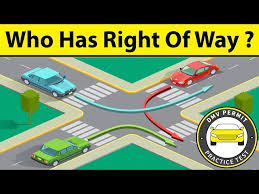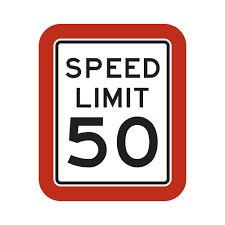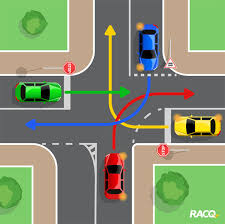
Article:
Intersections are some of the most common areas for accidents, especially for learner drivers. Understanding right of way rules and intersection procedures is essential for safe driving and passing your test with confidence.
1. What is Right of Way?
Right of way determines which driver has priority in different driving situations. It helps prevent collisions by clarifying who should go first. Knowing when to yield, stop, or proceed is critical.
2. Stop and Give Way Signs
Stop Signs: Come to a complete stop at the line, crosswalk, or intersection, then proceed only when safe.
Give Way Signs: Slow down and be ready to stop if another vehicle has priority.
Tip: Always scan all directions before moving, even if you technically have right of way.
3. Uncontrolled Intersections
Intersections without signs or signals require extra caution. Typically, you must give way to vehicles approaching from the right.
Tip: Approach slowly, look carefully in all directions, and proceed only when safe.
4. Roundabouts
Vehicles inside the roundabout generally have priority.
Signal when exiting.
Choose the correct lane depending on your intended exit.
Tip: Enter carefully, keep a steady speed, and watch other drivers’ signals.
5. Pedestrian Crossings
Pedestrians always have right of way at crossings, whether controlled or uncontrolled. Stopping for pedestrians is mandatory.
Tip: Reduce speed when approaching crossings and be prepared to stop, especially near schools or busy areas.
6. Turning Rules
Left Turn: Give way to oncoming traffic unless indicated otherwise.
Right Turn: Yield to pedestrians and cyclists.
Tip: Always signal in advance and check all directions before turning.
Conclusion:
Mastering right of way and intersection rules is essential for safe driving. Learner drivers who understand these rules are less likely to have accidents, more confident behind the wheel, and better prepared to pass their driving test. Regular practice and guidance from an instructor will help solidify these skills.













1 Comment
NightingalePDFspary
Are you searching for a reliable source to read this bestseller? We offer The Nightingale in a convenient PDF file for all book lovers. Immerse yourself in the rich details of French history and the intense emotional landscape of this celebrated novel. https://thenightingalepdf.top/ what is the florence nightingale effect